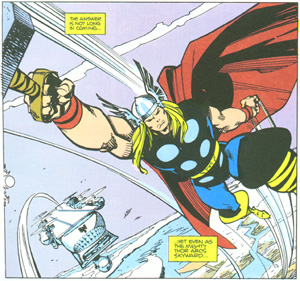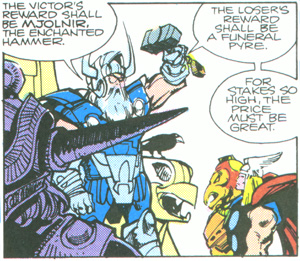Thor Visionaries: Walt Simonson Vol. 1
Here's an unpublished review I wrote a couple of years ago about one of my Favorite Comics Ever. (In fact, this is probably the one that I picked up in high school that cemented my expensive return to the hobby.) Volume 2 was just released.
 The major American comic book publishers, Marvel and DC, have published shared-universe fiction for more than sixty years. Many of the super-hero titles that contribute to these shared universes draw from different genres: the urban grit of modern Batman comics happens in the same world where mermaids swim in Atlantis and technological monstrosities attack from outer space. This mixing of genres can foster either new creative possibilities -- or an awkward mess.
The major American comic book publishers, Marvel and DC, have published shared-universe fiction for more than sixty years. Many of the super-hero titles that contribute to these shared universes draw from different genres: the urban grit of modern Batman comics happens in the same world where mermaids swim in Atlantis and technological monstrosities attack from outer space. This mixing of genres can foster either new creative possibilities -- or an awkward mess.
Nowhere has this been clearer than in Marvel Comics' title, Thor. The first issue, created by comic book legends Stan Lee and Jack Kirby, featured a newly-awakened modern day Norse god of thunder battling -- I kid you not -- the Stone Men from Saturn. Admittedly, this was a product of the early 1960s. A certain level of silliness was to be expected. But any scholar of Norse myth had only to glance at the cover to see that the contents would not draw heavily from the Elder Eddas.
Thor's hair was blond, not red; his face clean-shaven, not bearded. He was intelligent and noble, not dim and foolhardy. Odin was frequently drawn with two intact eyes. Asgard, home of the Norse gods, was frequently depicted as a land of superscience. Asgardians spoke in odd pseudo-Elizabethan dialogue -- with "thous" and "thees" and "mayests" and "smiteths" -- more suggestive of the King James Bible than Viking sagas. In short, despite Lee and Kirby's periodic "Tales of Asgard" backup strips that attempted a more mythological flavor, Thor was built on only a fraction of the richness of Norse mythology. Alongside Captain America, Spider-Man, and Iron Man, Thor found himself fighting aliens, rival pantheons (he and Hercules had a strong rivalry), and villains like the Absorbing Man. Sometimes it worked. And sometimes Thor looked horribly out of place -- how seriously can you take a longhaired guy with a funny helmet and a funnier speech pattern?
 Especially for modern, older comic book audiences, writers of Thor must walk a fine line between being an active part of the Marvel shared universe and taking advantage of the title's great asset: the richness of Norse myth. Longtime fans, veteran writers and critics have pointed to one writer-artist whose stories struck that balance dead on, creating an run of stories that has held up for almost twenty years. Walter Simonson's tenure lasted from issue #337 in 1983 to issue #382, which celebrated the Marvel character's 30th anniversary. With Thor Visionaries: Walter Simonson, Marvel Comics has begun reprinting those stories.
Especially for modern, older comic book audiences, writers of Thor must walk a fine line between being an active part of the Marvel shared universe and taking advantage of the title's great asset: the richness of Norse myth. Longtime fans, veteran writers and critics have pointed to one writer-artist whose stories struck that balance dead on, creating an run of stories that has held up for almost twenty years. Walter Simonson's tenure lasted from issue #337 in 1983 to issue #382, which celebrated the Marvel character's 30th anniversary. With Thor Visionaries: Walter Simonson, Marvel Comics has begun reprinting those stories.
The new direction begins with a classic comic book conundrum -- a threatening alien ship (which strongly resembles the space battleships of Leiji Matsumoto's Space Cruiser Yamato and Captain Harlock) is heading for Earth. Thor battles the cyborg warrior within, but Simonson turns expectations on their head when the alien wrests away Thor's hammer, which should be impossible. This proves, due to the hammer's enchantment, that the alien is Thor's equal in nobility and valor. The first stories in Thor Visionaries: Walter Simonson follow Thor and the alien -- whose improbable name is "Beta Ray Bill" -- on their journey from rivals to allies as they rescue Bill's people from a demon horde.
 As with J. Michael Straczynski's later approach to the television series Babylon 5, Simonson initially hides the story arc he is carefully constructing. The "Beta Ray Bill" stories provide a science fiction-themed opening to a modern-day epic of high fantasy melded to the superhero genre. The demonic assault on Bill's people provides the first hint that a great danger is building. As Thor battles a dragon in the heart of New York City, encounters the last ancient Viking, and is pursued by an Asgardian temptress, he and his fellow Norse gods become aware of increasingly strong rumblings of danger. Meanwhile, a great being of fire slowly forges a sword of immense power -- the significance of which would not be lost on readers familiar with Norse mythology. Simonson is building toward a Marvel Universe rendition of what could literally be called the ultimate Norse saga.
As with J. Michael Straczynski's later approach to the television series Babylon 5, Simonson initially hides the story arc he is carefully constructing. The "Beta Ray Bill" stories provide a science fiction-themed opening to a modern-day epic of high fantasy melded to the superhero genre. The demonic assault on Bill's people provides the first hint that a great danger is building. As Thor battles a dragon in the heart of New York City, encounters the last ancient Viking, and is pursued by an Asgardian temptress, he and his fellow Norse gods become aware of increasingly strong rumblings of danger. Meanwhile, a great being of fire slowly forges a sword of immense power -- the significance of which would not be lost on readers familiar with Norse mythology. Simonson is building toward a Marvel Universe rendition of what could literally be called the ultimate Norse saga.
Simonson's Thor stories are heavily plot-driven, but he finds a way to use the limited space of 22-page comics to develop the supporting cast to an extent never before accomplished in the title, creating a true ensemble piece. In his hands, the god of mischief Loki graduates from a super-villain caricature to a subtle, capable menace. Similarly, the buffoonish Volstagg, created by Lee and Kirby for comic relief, is given a more nuanced, fatherly relationship to the tragic Balder. His art is still distinctive even eighteen years later. He uses graphic ornamentation to strong effect within and outside panel borders, draws with angular and dynamic lines, and mixes ancient, modern, and futuristic environments almost seamlessly.
Thor Visionaries: Walter Simonson is not perfect. Readers must have patience with the tropes of the super-hero genre, including extended monologues in the heat of battle. Even though Simonson has gotten rid of the archaic "thees" and "thous" for the most part, the elevated style of dialogue still leads to a few groaners, such as, "Now speak before I unleash my fury!" Word balloons are sometimes confusingly placed, and a printing error switched two pages in the first issue (although it is easy to figure out the proper order). Because the book is reproduced from 1980s-era color separations intended for newsprint, the color looks a little garish on high-quality paper when compared to modern comics.
These flaws aside, this is the first chapter of a genuine epic of comic book storytelling, and the cliffhanger on the last page leaves the reader eager for the next collection. Together, Simonson's 45 issues meld the best of the superhero genre with the source material that had been strangely lacking in _Thor_ until then: the grandeur and heroism of Viking mythology. By finally reprinting these titles, Marvel Comics is showing a new generation of readers the possibilities that modern comics, with so many genres and sources to draw from, have to offer.
Comments
I found this entry while searching for a TP or graphic novel on this great plot line. I think this plotline had the greatest effect on me of any comic so far.
Thanks for the post.
Posted by: Aaron | May 5, 2006 10:47 AM